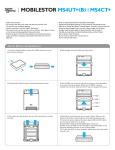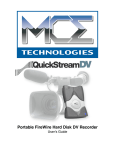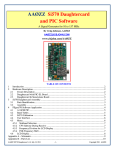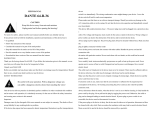Download Apple PowerBook 3400c Installation guide
Transcript
MobileStor PowerBook Internal Hard Drive with Installation Kit Installation Guide for PowerBook 3400 and PowerBook G3 http://www.mcetech.com 2 PowerBook 3400 and PowerBook G3 (1997) Introduction to PowerBook 3400/G3 Installation This chapter details the procedure for installing an MCE hard drive upgrade kit into a PowerBook 3400 or the original PowerBook G3 (1997 release; a.k.a. Kanga). ! Note: This section pertains to the PowerBook 3400 and PowerBook G3 model that have a multi-colored Apple logo both on the outside of the top cover and below the display. MCE strongly recommends that the installation be performed by a qualified technician. The installation procedure involves disassembling the PowerBook and exposing its sensitive electronics. This is a delicate process and, if not performed properly, could cause damage to the PowerBook. These installation instructions are given for those who understand these risks. If performed correctly, these instructions will guide an individual step-by-step through a successful installation of the new hard drive. The new hard drive comes formatted and initialized with a Macintosh driver, but generally requires the installation of appropriate Macintosh operating system (Mac OS) software for use in the PowerBook. You will need a reliable Macintosh volume from which to boot the PowerBook in order to load the necessary operating system software. Once the PowerBook is booted, the new hard drive will automatically mount onto the PowerBook’s Desktop and is ready for software installation. If the drive does not mount onto the Desktop, the PowerBook may prompt you to initialize the hard drive upon startup, after which the drive should then automatically mount onto your Desktop and be ready for software installation. See the PowerBook User’s Manual for operating system and other software installation procedures. ! Caution: Due to a bug in Apple’s ROM support for SCSI Disk Mode, a PowerBook 3400/G3 which has an internal IDE hard drive PowerBook 3400 and PowerBook G3 (1997) 3 larger than 4GB installed cannot be used in SCSI Disk Mode. One can use this PowerBook with an internal drive larger than 4GBin normal Macintosh mode. There is no workaround for reliably using such a PowerBook in SCSI Disk Mode. It is recommended that one use an Ethernet connection to transfer files if necessary. Installation Checklist In addition to the new hard drive, the following items should also be found in this PowerBook hard drive upgrade kit: - (1) Disposable Grounding Wrist Strap - (1) MCE Standard/Phillips Combo Screwdriver - (1) Torx T8 Screwdriver Installation Procedure ! Caution: Electro-Static Discharge (ESD) can easily damage electronic components. Before proceeding, ensure that you are discharged of static electricity by touching a grounded metal object and by properly securing the provided Disposable Grounding Wrist Strap. Step 1: Place your PowerBook on a hard, flat surface. Step 2: If your PowerBook is on, turn it off. If the unit appears to be off, make sure that it is not in Sleep mode. Step 3: Completely unplug all cables from the PowerBook and remove any PC Card modules from it. Step 4: Remove the battery by pushing the latch button in and sliding the latch to the side. Pull the battery completely out of the PowerBook. Latch Battery 4 PowerBook 3400 and PowerBook G3 (1997) (Rear View) Step 5: To remove the floppy/CDROM drive assembly without damaging it, turn the unit upside down as shown. Slide the release button outward. Grasp the ridged area of the plastics (not the metal cover) to prevent bending the metal top case and possibly damaging the drive. Grasping the assembly by its ridged area, pull it out of the media bay. Step 6: Close and latch the PowerBook and turn it upside down. Remove the 3 screws on the bottom of the case with the torx screwdriver. ! Floppy Drive Assembly Ridged Area Release Button Screw Screw Caution: If you pull the keyboard too far you will rip the keyboard cables out of their connectors. Perform the next steps slowly and carefully. Step 7: Turn the PowerBook right-side-up, front facing you and lift open the display. Rotate the Speaker display as far back as it will go Grill away from you, probably, around 170° from the base of the PowerBook. Using the small flat-blade screwdriver to get underneath it, lift the keyboard slightly up and toward you until you feel a small resistance (its four top interior tabs should just clear the speaker grill). STOP! Screw PowerBook 3400 and PowerBook G3 (1997) Step 8: Gently rotate the top of the keyboard (the end closest to the display) toward you, laying it face down onto the palm rest. Step 9: Using the small flat-blade screwdriver, detach the two keyboard cables by gently lifting up their respective connector ears. Remove the keyboard, and set it safely aside. Keyboard Cable Connectors Keyboard Turned Over RAM Card Step 10: If present, grasp the RAM card by the corners closest to you (supporting the bottom left corner over the connector and lift straight up. Step 11: Carefully detach the brightness & speaker cable from its connector. Remove the screw from the brightness and speaker grill. Lift off the grill (the piece under the up arrow in the picture) until you feel a slight resistance. STOP! Brightnes & Speaker Grill Screw 5 6 PowerBook 3400 and PowerBook G3 (1997) Step 12: Rotate the top of the grill toward the front of the PowerBook. Use your fingers to disconnect the backup battery connector. (The backup battery is adhered to the grill with reusable adhesive. This does not need to be removed from the grill.) Backup Battery Connector Backup Battery Step 13: Grasp the area of the clutch cover under the display. Using a fingernail, pull up from the seam in Clutch Cover back and gently rock the clutch cover until it releases. Pull the clutch cover straight up, watching to clear the bottom of the display assembly. ! Clutch Cover Note: Familiarize yourself with the palm rest. This section will have to be rotated into the area originally occupied by the keyboard. Be carefull not to pull the trackpad cable out of the connector as you turn over the palm rest. Perform the next steps carefully. Palm Rest Tab Latch Step 14: Grasp the right corner of the palm rest and gently but firmly pull it up. PowerBook 3400 and PowerBook G3 (1997) 7 Step 15: Referring to the latch noted on the previous diagram, use a small flat-blade screwdriver to gently press the latch toward the palm rest and at the same time rotate the top right section of the palm rest towards the front of the PowerBook. Step 16: Once the latch is freed, grasp the top right side of the palm rest and pull it up slowly. Note that there are six more latches connecting the palm rest, along the front and middle seams. Some of these latches may be a bit tough to release, especially along the left front seam. You might try gently rocking the palm rest to free these latches. You might also try pushing with your thumbs on the bottom half of the case below the front seam as you pull the top palm rest area with your other fingers. Step 17: Rotate the palm rest over until it is laying upside down in the area that the keyboard originally occupied, remembering not to pull the trackpad cable out of the connector as you turn over the palm rest. Step 18: Remove the three interchangeable screws connecting the hard drive bracket to the CPU stiffener. Lift up the bracket until you feel a slight resistance STOP! Notice the hard drive cable connecting the drive to the logic board. 8 PowerBook 3400 and PowerBook G3 (1997) ! Tip: There are two items that the bracket protects - the hard drive and the power supply board underneath the right side of the bracket. When separating the bracket from the computer use a small flat-blade screwdriver to hold down the power supply board. Do this by applying slight pressure to the right edge of the board. Touch only the green part of the IC board. Step 19: While holding the power supply board in place rotate the bracket towards the front of the PowerBook. Disconnect the hard drive cable connector from the logic board by carefully pulling up on the hardened plastic back of the cable. Screw Screw Screw Hard Drive Cable Screw Step 20: Remove the four screws holding the drive in the bracket. Cable Step 21: Remove the hard drive from within the bracket. Use the pull tabs to disconnect the cable from the hard drive. Pull Tab Step 22: Replace the cable connector onto the new hard drive taking care to orient it properly for later connection of the other end of the cable to the logic board. PowerBook 3400 and PowerBook G3 (1997) ! 9 Caution: Note that the ribbon cable connector does not attach to the “Group B” pins in the diagram below. The same is true when you re-attach the connector to the new drive. Group A Group B Hard Drive Pins gap • Reverse the relevant previous steps to reassemble the computer. Replacement Notes Install the palm rest before the clutch covers. The palm rest tabs fit under the clutch cover tabs. When replacing the keyboard screws, you may have to apply pressure to the keyboard for the screws to engage. Apply pressure with great care. When reinserting the floppy drive align the bay device carefully. Tolerances are tight. As always, install the PowerBook’s battery before connecting the AC power adapter. Congratulations! You have completed the hardware installation of your PowerBook hard drive upgrade. ! Note: It is normal for usable hard drive capacities to be reduced by 5-7% upon initialization of the drive. Also, your drive ships preformatted and initialized, but does not include system software on it. If you have the appropriate hardware, such as the MCE Transport PC Card Kit, you may transfer the data from the original internal hard drive to the new internal hard drive. If not, you may need to re-install your system software and other applications from the original disks or CD-ROM disc. Consult the manual(s) that came with your PowerBook for details. MobileStor Installation Guide Limited Warranty This is your MCE Technologies, LLC (MCE) three year limited warranty. The original purchaser (Purchaser) must present a dated proof of purchase (Bill of Sale) to obtain warranty service. This product is warranted by MCE to be free from defects in material and workmanship for three (3) years from the date of purchase by the Purchaser. Purchaser's sole remedy under an MCE warranty shall be, at MCE's sole election, refund, repair or replacement as provided in this warranty. An MCE warranty shall not apply to any failure or defect caused by misuse, abnormal use, neglect, abuse, alteration, improper installation, unauthorized repair or modification, improper testing, accident or causes external to the product such as but not limited to excessive heat or humidity, power failure, or surges, or improper installation, or damage arising from improper packaging during transport; and damage resulting from causes, including without limitation, lack of technical skill, competence, or experience of the user. This warranty shall not be enlarged, diminished or affected by, and no liability shall arise out of, MCE's rendering of technical advice or providing information to Purchaser. Service by anyone other than MCE authorized service personnel voids any MCE warranty. MCE makes no representations or warranties, express or implied, regarding the fitness of a product for any particular purpose, or that a product is compatible with any particular hardware or software. MCE's sole and exclusive maximum liability for any claim by Purchaser arising out of Purchaser's purchase of a product and/or the above warranty shall not in any event exceed the actual amount paid by Purchaser for the product. In no event shall MCE be liable for any direct, indirect, incidental, collateral, exemplary, consequential or special damages or losses arising out of Purchaser's purchase and/or use of products, including, without limitation, loss of use, profits, goodwill or savings, or loss of data, data files, or programs that may have been stored by a user of the product. Continued use or possession of a product after expiration of its warranty period shall be conclusive evidence that the warranty is fulfilled to the full satisfaction of Purchaser. MCE shall honor the terms of an MCE warranty as described herein, provided that the defective product is sent in its original packaging to MCE, together with a copy of the dated proof of purchase on which the product appears, transportation and insurance prepaid, within the warranty period, and if the product is found by MCE to be defective within the terms of the warranty. Prior to returning any product to MCE, Purchaser must obtain a Return Merchandise Authorization (RMA) number from MCE. No product shall be accepted for return, repair or replacement without an RMA number visibly written on the outside of its original packaging or comparable packaging affording an equal degree of protection. MCE shall not be responsible for merchandise sent to MCE improperly packaged. Purchaser must prepay shipping charges for merchandise shipped back to MCE for warranty service. Prior to returning the product, Purchaser must, if possible, remove any and all programs and data from any storage media. Replacement products and parts used to repair products may be similar new or other than new items. Replaced products and parts shall become the property of MCE. If any product returned by Purchaser to MCE for repair or replacement is not defective within this warranty, MCE shall so advise Purchaser and thereafter MCE shall handle such products in accordance with Purchaser's instructions and at Purchaser's cost, after reimbursement to MCE by Purchaser of freight charges at then current rates, and examination and testing expenses at then current rates ($60.00 per hour as of January 2001). Prices, terms and conditions are subject to change without notice. Non-defective purchases which are returned to MCE must be returned within thirty (30) days of purchase. For non-defective purchases which are returned or refused by the Purchaser, MCE will, at its discretion, issue a credit or refund for the purchase price of the goods, less all shipping charges incurred in the shipment and a restocking fee of no less than fifteen percent (15%) of the retail price of the goods. MCE Technologies, LLC Irvine, California, USA Technical Support (949)458-0800 [email protected] Sales (800)500-0622 [email protected] http://www.mcetech.com Copyright © 2001 MCE Technologies, LLC. All rights reserved. MCE, the MCE logo, and MobileStor are trademarks of MCE Technologies, LLC. Apple, Mac, the Mac OS logo, Macintosh, PowerBook, iBook, and Drive Setup are trademarks of Apple Computer, Inc. registered in the U.S. and other countries. Products and company names are trademarks of their respective companies, and are mentioned for informational purposes only and constitute neither an endorsement nor a recommendation. Every effort has been made to ensure that the information in this manual is accurate. MCE Technologies, LLC is not responsible for printing or clerical errors. Information in this document is subject to change without notice and does not represent a commitment on the part of MCE Technologies, LLC. Rev. 0328

























